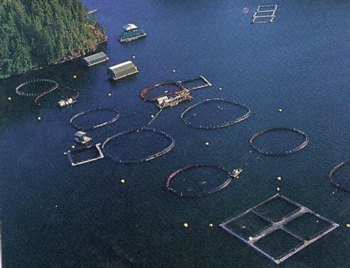Maine Aquaculture Diversifies with Eels, Scallops & Seaweed
by Laurie Schreiber

Salmon pens.
Maine’s aquaculture industry is seeing more diversity and opportunities than ever before, and still has plenty of room to grow.
That was the consensus of speakers at the fourth Maine Aquaculture Research, Development and Education Summit, held Jan. 17 at the University of Maine Hutchinson Center in Belfast.
Co-hosted by the Maine Aquaculture Innovation Center and UMaine Aquaculture Research Institute, the summit cover statewide aquaculture initiatives and industry updates, addressed barriers and needs, and offered potential solutions for key issues.
The industry has grown and changed quite a bit in the last few years, said Chris Davis, executive director for the Maine Aquaculture Innovation Center (MAIC) in Walpole.
It’s becoming increasingly diverse, with companies that grow finfish, shellfish, and seaweed. The industry includes small and medium-size businesses; many are new as of the last few years.
Sebastian Belle, executive director of the Maine Aquaculture Association (MAA) said the number of young people getting onboard, compared with 20 years ago, was “astounding. Young folks today are excited to build the sector….We’ve turned a corner here.”
In January, MAIC, in cooperation with the Maine Aquaculture Association, Maine Seat Grant, and the University of Maine’s Aquaculture Research Institute, completed a research priorities survey of the industry. Priorities included workforce development; climate change impacts; pest, invasive species and biofouling management; and development of public information and marketing materials.
The industry in general said it wanted to improve community relations and to learn how to work with riparian owners, Davis said.
The industry stands to benefit from grants to help build capacity, said Gayle Zydlewski, director of Maine Sea Grant. Last fall, Maine Sea Grant, University of Maine researchers, other institutions, and partner organizations received $1.6 million from NOAA’s National Sea Grant Program to lead four projects in collaboration with the aquaculture industry, management and community partners.
The hub’s goal is
to help the industry
overcome barriers associated
with commerce, permitting
and policies.
The U.S. currently imports 85% of its seafood. As seafood consumption continues to rise, wild-caught fisheries are not expected to meet demands. That results in new opportunities for aquaculture, according to a University of Maine press release. Other industry drivers include increased demand for domestic, locally sourced and sustainably produced protein, and the need to diversify working waterfront.
The Maine Sea Grant money will focus on three areas: accelerate the development of collaborative networks, explore new aquaculture opportunities, and fill gaps in social, behavioral, and economic knowledge relating to aquaculture and communities it impacts and serves.
With the UMaine Aquaculture Research Institute, Maine Aquaculture Association, Coastal Enterprises Inc., Maine Aquaculture Innovation Center, and UMaine School of Marine Sciences, Maine Sea Grant is leading a $1.2 million project to establish a Maine Aquaculture Hub to build capacity for industry-driven innovation, diversification, and workforce development.
Among its activities, the hub will develop a 10-year roadmap. Collaborators will conduct stakeholder and industry focus groups to reexamine an aquaculture economic development plan issued in 2010, assess Maine’s progress in its implementation, and construct a new set of action items to guide aquaculture development for the next 10 years. The hub’s goal is to help the industry overcome barriers associated with commerce, permitting and policies, new species, production systems, and seafood safety and quality. The award also will help train entrants to the industry and support workforce development for existing businesses through an expansion of the Aquaculture in Shared Waters training program, established in 2013.
Maine Sea Grant and Maine scientists will also collaborate on a $1.2 million Maryland Sea Grant project to build capacity of land-based Atlantic salmon aquaculture in the U.S. and a $1 million Connecticut Sea Grant project to nurture the growth of a domestic seaweed aquaculture industry.
Other awards include:
• $249,424 to examine public perceptions of recirculating aquaculture systems (RASs)
• $76,868 to develop an innovative ocean-bottom cage and hauling technology for commercial shellfish growers.
• $65,172 to examine the viability of quahog and oyster cultivation, considered a potential diversification strategy for shellfish harvesters who’ve been impacted by historically low soft-shell clam landings as well as for oyster farmers looking to hedge against a rapidly increasing supply of oysters in Maine and across the Northeast.
A portion of the funds will be awarded to Maine companies and industry partners, Zydlewski said. The organization has issued a call for proposals from industry members, who are encouraged to submit collaborative proposals with other growers and partners, she said.
